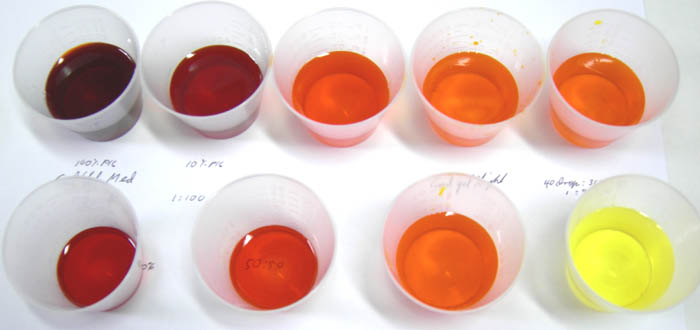Post by Admin on Jul 23rd, 2009 at 9:10am
The RCW exemplifies a distinguished pattern that utilizes 3, 6, 12, 24, 36, 48, 60, 72, 84, 108, 144, 1080 and on to 1º color arcs (wedges), the RCW360 color wheel. Darker colors are in 10 blocks as are tints. Yellow is at the top and Read Red Right,
How do the cyan to blue and yellow to red wedges work?
Yellow and Orange darken to brown before any complement/opposite color is added into them. Burnt Sienna is #4.6.
Red darkens to brown with only its complement color, cyan. Red oxide is #7.6.
Blue use the pre-made pigments from French Blue, Ultramarine Blue to Ultramarine Blue Deep to get darker, no complement color is needed.
Cyan darkens to Ultramarine Blue's darks before any complement color is added into it.
All other colors in their color numbered pie shaped wedges or arcs use the opposite color to reach neutral-dark.
The wedges yellow to orange and cyan to blue are similar to each other in that they use a different pigment color to get darker. The rest of the RCW colors all darkened with just the opposite color.
Pure Magenta; 36RCW#13.0 = 100% magenta (+) 0% green.
Dark Magenta; #13.10 = 100% magenta (+) 100% green.
That is how 2/3's of the color wheel works, just by adding the opposite color.
#7 red makes the dark brown by adding its opposite color cyan. Blue and cyan make a neutral dark after the dark blue block is added. Some day the cyan to dark blue will be one transparent pigment instead of two but no one is willing to produce it yet. Except the Japanese car manufactures, they have it already. A transparent cyan with a mass-tone of Ultramarine blue, it's coming, I saw a really nice truck painted with it a few weeks ago (2008), it blew my mind. Artists still don't have the pigment in 2013.
Yellow makes neutral darks after the dark brown at the bottom of the wedge. Here is a photo of the brown liquid made from the dry pigment, Tartrazine. Tartrazine is not a pigment for sale in tubes yet as of 2013, but it will be. The photo is for proportions to use it as ink in my plotter. The third from the bottom end is what I use, 29:1.
(7 parts ethanol glycol mixed with 7 parts water plus 1 part Tartrazine)
36RCW#25 transparent cyan and opaque red, 36RCW#7, are opposite colors. Mixed together with any block in the opposite arc will mix a neutral dark, red oxide (Venetian red) is #7.5.
1 part of cyan and 1 part of magenta will make an ultramarine blue hue.
2 parts of cyan and 1 part of magenta make a cobalt blue hue.
Cyan, Cobalt Blue and Ultramarine Blue will mix the same neutral dark with their opposite pie shaped wedges of color.
#7.10 Bt. Umber Brown dark to #7.6 warm Red Oxide to #7.0 Cadmium Red Light, mixed with #25 Cyan will mix dark-neutral.
CYAN 36RCW#25.0 to DARK BLUE 36RCW#25.10
| cyan | #25.0 = 100% | intensity | cyan 100% + | 00% French blue | cyan | #25.1 = 90% | intensity | cyan 90% + | 10% ultramarine blue | cyan | #25.2 = 80% | intensity | cyan 80% + | 20% ultramarine blue | cyan | #25.3 = 70% | intensity | cyan 70% + | 30% ultramarine blue | cobalt | #25.4 = 60% | intensity | cyan 60% + | 40% ultramarine blue | cobalt | #25.4 = 50% | intensity | cyan 50% + | 50% ultramarine blue | blue | #25.4 = 40% | intensity | cyan 40% + | 60% ultramarine blue | blue | #25.4 = 30% | intensity | cyan 30% + | 70% ultramarine blue | blue | #25.4 = 20% | intensity | cyan 20% + | 80% dark blue | blue | #25.4 = 10% | intensity | cyan 10% + | 90% dark blue | blue | #25.4 = 00% | intensity | cyan 00% + | 100% darkblue | |
1 part blue + 1 part red's brown or yellow's brown
(the same color)
